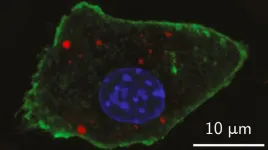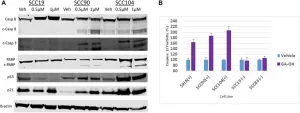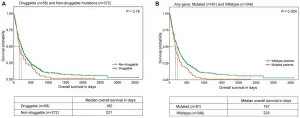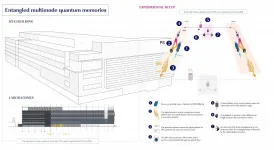New nanoparticle design paves way for improved detection of tumors
2021-06-02
(Press-News.org) Nano-sized particles have been engineered in a new way to improve detection of tumors within the body and in biopsy tissue, a research team in Sweden reports. The advance could enable identifying early stage tumors with lower doses of radiation.
In order to enhance visual contrast of living tissues, state-of-the-art imaging relies on agents such as fluorescent dyes and biomolecules. Advances in nanoparticle research have expanded the array of promising contrast agents for more targeted diagnostics, and now a research team from KTH Royal Institute of Technology has raised the bar further yet. They are combining optical and X-ray fluorescence contrast agents into a single enhancer for both modes.
Muhammet Toprak, Professor of Materials Chemistry at KTH, says the synthesis of contrast agents introduces a new dimension in the field of X-ray bio-imaging. The research was reported in the American Chemical Society journal, ACS Nano.
"This unique design of nanoparticles paves the way for in vivo tumor diagnostics, using X-ray fluorescence computed tomography (XFCT)," Toprak says.
He says the new "core-shell nanoparticles" may have a role to play in the development of theranostics, a portmanteau for therapy and diagnostics, in which for example single drug-loaded particles could both detect and treat malignant tissues.
The core-shell contrast agent gets its name from its architecture: it consists of a core combination of nanoparticles with previously-established potential in X-ray fluorescence imaging, such as ruthenium and molybdenum (IV) oxide. This core is encased in a shell comprised of silica and Cy5.5, a near-infrared fluorescence-emitting dye for optical imaging techniques such as optical microscopy and spectroscopy.
Toprak says that encapsulating the Cy5.5 dye within the silica shell improves the agent's brightness and extends its photo-stability--enabling the dual optical/X-Ray imaging approach. In addition, silica provides the benefit of tempering the toxic effects of the core nanoparticles.
Tests with laboratory mice have shown that the XFCT contrast agents enable location of early stage tumors of only a few millimetres in size.
Toprak says the technology opens the possibility to identify early stage tumors in living tissue. That's because the presence of multiple contrast agents increases the odds that diseased areas will show up in scans, even as the distribution of the nanoparticles becomes obscured by their interaction with proteins or other biological molecules.
"Nanoparticles of different size, originating from the same material, don't appear to be distributed in the blood in the same concentrations," Toprak says. "That's because when they come into contact with your body, they're quickly wrapped in various biological molecules--which gives them a new identity."
A multitude of contrast agents for XFCT would enable studying the biodistribution of nanoparticles in-vivo using low-dose X-rays, he says. That would allow identifying the best size and surface chemistry of the nanoparticles for the desired targeting and imaging of the diseased region.
INFORMATION:
In addition to Toprak, the study was co-authored by Giovanni M. Saladino, Carmen Vogt, Yuyang Li, Kian Shaker, Bertha Brodin, Martin Svenda and Hans M. Hertz.
[Attachments] See images for this press release:

ELSE PRESS RELEASES FROM THIS DATE:
2021-06-02
Researchers from Sinai Health have published a study providing an ultra-detailed look at the organization of a living human cell, providing a new tool that can help scientists around the world better understand what happens during disease.
The new study, out today in the journal END ...
2021-06-02
In the universe's earliest moments, particles existed in an unimaginably hot plasma, whose behaviour was governed by deeply complex webs of interaction between individual particles. Today, researchers can recreate these exotic conditions through high-energy collisions between heavy ions, whose products can tell us much about how hot, strongly-interacting matter behaves. Yet without extensive, highly coordinated collaborations between researchers across many different backgrounds, studies like this simply wouldn't be possible. This Topical Issue of EPJ A draws together a large collection of papers inspired by the theory of hot matter and relativistic heavy-ion collisions (THOR) European Cooperation ...
2021-06-02
The myriad processes occurring in biological cells may seem unbelievably complex at first glance. And yet, in principle, they are merely a logical succession of events, and could even be used to form digital circuits. Researchers have now developed a molecular switching circuit made of DNA, which can be used to mechanically alter gels, depending on the pH. DNA-based switching circuits could have applications in soft robotics, say the researchers in their article in Angewandte Chemie.
DNA is a long molecule that can be folded and twisted in various ways. It has a backbone and bases that stick out from the backbone and pair up with counterparts in other DNA strands. When a series of these matching pairs comes ...
2021-06-02
It's strawberry season in many parts of the U.S, and supermarkets are teeming with these fresh heart-shaped treats. Although the bright red, juicy fruit can grow almost anywhere with lots of sunlight, production in some hot, dry regions is a challenge. Now, researchers reporting in ACS' Journal of Agricultural Food and Chemistry have identified five cultivars that are best suited for this climate, which could help farmers and consumers get the most fragrant, sweetest berries.
Most strawberries commercially grown in the U.S. come from California and Florida. With the expansion of local farmer's markets and people's excitement ...
2021-06-02
Aging published "Cdkn1a transcript variant 2 is a marker of aging and cellular senescence" which reported that cellular senescence is a cell fate response characterized by a permanent cell cycle arrest driven primarily the by cell cycle inhibitor and tumor suppressor proteins p16Ink4a and p21Cip1/Waf1. In mice, the p21Cip1/Waf1 encoding locus, Cdkn1a, is known to generate two transcripts that produce identical proteins, but one of these transcript variants is poorly characterized. The authors show that the Cdkn1a transcript variant 2, but not the better-studied variant 1, is selectively elevated during natural aging across multiple mouse tissues. Importantly, mouse cells induced ...
2021-06-02
Oncotarget published "A high-content AlphaScreen™ identifies E6-specific small molecule inhibitors as potential therapeutics for HPV+ head and neck squamous cell carcinomas" which reported that the incidence of human papillomavirus-positive head and neck squamous cell carcinoma has increased dramatically over the past decades due to an increase in infection of the oral mucosa by HPV.
The etiology of HPV -HNSCC is linked to expression of the HPV oncoprotein, E6, which influences tumor formation, growth and survival.
E6 effects this oncogenic phenotype in part through inhibitory ...
2021-06-02
Oncotarget published "Molecular characterization of lung squamous cell carcinoma tumors reveals therapeutically relevant alterations" which reported that unlike lung adenocarcinoma patients, there is no FDA-approved targeted-therapy likely to benefit lung squamous cell carcinoma patients.
The authors performed survival analyses of lung squamous cell carcinoma patients harboring therapeutically relevant alterations identified by whole exome sequencing and mass spectrometry-based validation across 430 lung squamous tumors.
They report a mean of 11.6 mutations/Mb with a characteristic smoking signature along with mutations in TP53, CDKN2A, NFE2L2, FAT1, KMT2C, LRP1B, FGFR1, PTEN and PREX2 among lung squamous cell carcinoma patients of Indian descent.
In overall, the data suggests 13.5% ...
2021-06-02
When the COVID-19 pandemic arrived in North America in March 2020, health care facilities stopped providing all but "essential" care, to reduce infection risks and preserve protective gear known as PPE.
That included changes at many centers that provide ECT (electroconvulsive therapy) for severe depression and other conditions, a new survey shows.
Because ECT involves anesthesia, so that patients are unconscious when carefully controlled pulses of electricity are delivered to key areas of the brain, it is considered an 'aerosol generating' procedure. That means it poses special risks when a respiratory ...
2021-06-02
* ICFO researchers report in Nature on having achieved, for the first time, entanglement of two multimode quantum memories located in different labs separated by 10 meters, and heralded by a photon at the telecommunication wavelength.
* The scientists implemented a technique that allowed them to reach a record in the entanglement rate in a system that could be integrated into the fibre communication network, paving the way to operation over long distances.
* The results are considered a landmark for quantum communications and a major step forward in the development of quantum repeaters for the future quantum internet.
During the 90s, engineers made major advances in the telecom arena spreading out the network to distances beyond the ...
2021-06-02
TROY, N.Y. -- Oxygen levels in the world's temperate freshwater lakes are declining rapidly -- faster than in the oceans -- a trend driven largely by climate change that threatens freshwater biodiversity and drinking water quality.
Research published today in Nature found that oxygen levels in surveyed lakes across the temperate zone have declined 5.5% at the surface and 18.6% in deep waters since 1980. Meanwhile, in a large subset of mostly nutrient-polluted lakes, surface oxygen levels increased as water temperatures crossed a threshold favoring cyanobacteria, which can create toxins when they flourish in the form of harmful algal blooms.
"All complex life depends on oxygen. It's the support system for aquatic food webs. And when you start losing oxygen, you have the potential ...
LAST 30 PRESS RELEASES:
[Press-News.org] New nanoparticle design paves way for improved detection of tumors







